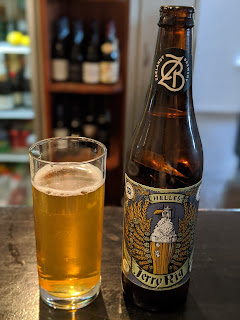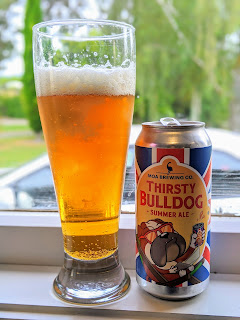Floating Rib NZ Helles
This beer turned out be a fairly good Helles lager. But when I was planning it I was actually aiming for a Pilsner. The first few tastes were disappointing, but when I stopped tasting it for what I wanted it to be, and appreciating it for what it was, I actually came to really enjoy it. A subtle NZ hop aroma, a fairly subdued bitterness, a slight hint of banana yeast flavour and a good solid malt overtone but overall a light and drinkable beer; just like a good Bavarian Helles (but made from more or less all NZ ingredients).
After my recent attempt at an NZ Pils (more German than Czech, more NZ than German was my aim), I altered the recipe a little. To be fair, after a bit of aging, the first one was actually fairly good, but I had a few things I wanted to improve on:
- Clearer beer
- Slightly heavier malt backbone
- Ever so slightly more amber colour (the last one was almost sickly watery pale)
- Slightly more aromatic hops flavour (to yell NZ hops in a subtle way), while maintaining good bitterness
To achieve that I changed the following:
1. Used Irish Moss in the boil. I've never used Irish moss before, but it's basically a fungus that causes proteins to clump together - the idea is you add it to the boil, and all the proteins (which cause haze in the beer) clump together and fall out of the beer during fermentation (so you get massive chunks at the bottom, but a clear beer). It was amazing, I've never seen antyhing like it. There was some serious chunks, and even for the first week or so there were large chunks of gloop at the top of the beer in the fermenter, but they all fell out, and the remaining stuff was much clearer than I've ever seen in a fermenter before. I also made sure to have long recirculations during the mash (pump the beer back over the grains kind of like a filter to get rid of any blobs and bits), and had a quick chill using the wort chiller to get from boiling to pitching temperature in about 15-20 mins. I also used dried hop cones insteaed of pellets and half the volume (see point 3).
2. Added 20% Munich malt (which undergoes a slightly different kilning process to Pilsner malt to give a slightly darker colour and a stronger malt flavour - I'm also half Bavarian, so feel an uncontrollabe urge to add this to beers) - aiming to improve the colour and maltiness.
3. Changed the hops bill - last time I used Waimea for bitterness and Riwaka for aroma (all at flame out). I got good bitterness, but bugger all aroma - so this time I used a more dual purpose hop - Motueka - for both bitterness and aroma, so I could add far less volume, and I added some at 5 mins and half as dry hops rather than at flame out. I also used dried cones rather than pellets (mainly to see if it helped with clarity). As an afterthought - I guess Tuatara probably use Motueka for their "Mot-Eureka" Pilsner.
In the end I achieved 3.5 out of the 4 goals - everything except maintaining the Pilsner bitterness. Which as I mentioned above actually makes it a fairly good Helles lager.
Numbers
- IBU 39 (according to the beer calculator - if I had to guess by taste I'd say it's closer to 20)
- Target start SG 1.053 Measured 1.048
- Target final SG 1.013, Measured 1.005
- Target colour: 4L
- Target ABV 5.3%, Calculated 5.6%
Setup
See this guy
Ingredients
All NZ ingredients, other than the yeast (I used a second generation [i.e. I'd used it in a previous brew] pilsner yeast).
All NZ ingredients, other than the yeast (I used a second generation [i.e. I'd used it in a previous brew] pilsner yeast).
- Gladfield German Pilsner Malt - 3.5kg (70%)
- Gladfield Munich Malt - 1kg (20%)
- Gladfield Gladiator Malt - 500g (10%) (equivalent of a cara-pils)
- Motueka Dried Cone Hops - 100g (30g first wort hop and 60 mins boil / 20g for 5 min boil / 50g dry hop for last 4 days in the primary)
- White Labs WLP800 Pilsner Yeast (Second generation) - With starter 3 days prior
- Palmerston North tap water
Yeast Starter
- 1.5L starter with 200mg Light DME
- Measured SG 1.042w
- Siphoned off clear stuff prior to pitching
Mash
- Thickness - 3L/kg (15L water, 5kg grain)
- Schedule - 1 hour, 66C (151F) single infusion mash (72C [162F] strike temperature)
- Recirculate 15 mins, Drain 10L (first wort hop 30g Motueka - pictured below)
- Sparge 9L (at 77 degrees) x2 (=28L minus equipment loss)
- Aim SG 1.053
Boil
- One hour boil
- 20g Motueka Cones at 55 mins (i.e. In boil for 5 mins)
- 5g Irish Moss at flame out
- Note my boiler crapped out, and I couldn't figure out why, so actually the flame went out some time between 50 and 55 mins, so the last 5 mins with the hops the boil was actually sitting close to 100 degrees but not quite boiling (grrr...)
- Whirlpool while chilling
Fermentation
Cooled to 21C before pitching the yeast. Usually with the Fermentasaurus I find the the 500mL collection bottle is full of trub within a few hours, but this time (due to the Irish Moss) it took quite a few days before I had a collection bottle full of grot. When it was full, it was turfed, and then as usual I didn't need to discard any more.
The pressure reached 15PSI within 24 hours, and I kept the pressure at that for the remainder of the fermentation. Last Pilsner I made I fermented warm at about 21-23 degrees (celsius), and I can only assume because of the pressure it still tasted good with minimal off flavours from the yeast. Thanks to a delightfully warm late summer this guy fermented even warmer at about 24-25 degrees.
After about 7-8 days most of the chunks had sunk to the fermentation collection, and after about 10-12 days most of the yeast had fallen out of suspension.
I added the dry hops with a little magnet trick I read about - prior to transferring the wort, get the dry hops in a hops bag with some magnets (a dollar or so from these guys on Ali Express), and then use the magnets to keep the bag of hops out of the beer until you're ready. Because the empty space fills up with CO2 fairly quickly, the hops shouldn't oxidise, although they are sitting at room temperature for over a week before being dunked. I shifted them down (using the magnets) four days before transferring to the keg, roughly when I'd judged fermentation to have stopped.
The pressure reached 15PSI within 24 hours, and I kept the pressure at that for the remainder of the fermentation. Last Pilsner I made I fermented warm at about 21-23 degrees (celsius), and I can only assume because of the pressure it still tasted good with minimal off flavours from the yeast. Thanks to a delightfully warm late summer this guy fermented even warmer at about 24-25 degrees.
After about 7-8 days most of the chunks had sunk to the fermentation collection, and after about 10-12 days most of the yeast had fallen out of suspension.
I added the dry hops with a little magnet trick I read about - prior to transferring the wort, get the dry hops in a hops bag with some magnets (a dollar or so from these guys on Ali Express), and then use the magnets to keep the bag of hops out of the beer until you're ready. Because the empty space fills up with CO2 fairly quickly, the hops shouldn't oxidise, although they are sitting at room temperature for over a week before being dunked. I shifted them down (using the magnets) four days before transferring to the keg, roughly when I'd judged fermentation to have stopped.
As usual with a pressure fermented brew, filled the sterilised keg with CO2 at 10 PSI (using the spunding valve to let gas out), hooked up the gas to the fermenter and maintained 15PSI and hooked up the transfer under pressure, so the beer never met any oxygen during the transfer. The Fermentasaurus is great for this with the floaty ball dip tube, as I could leave the murkiest 2L in the keg. (I ended up with 21L in the fermenter, and the keg only holds 19L, so I put the last bit into two 750mL bottles - let it go flat for a couple of days in the fermenter with the collection bottle on to get all the sediment out, and added a touch of DME so they could bottle condition).
A sneaky initial taste at transfer to the keg was promising - pretty clear, beautiful colour (the lighting in the photo below makes it look a bit more amber than it really was), and a bit more hoppy aroma than the fist attempt, while still being quite subtle and overall maintaining a Pils taste. Hopeful!
One of the big lessons I learnt from the first Pilsner, was that drinking lots of it before it's properly aged is bad, because it got better and better with time, and it peaked when most of it was already gone... So this time I made sure the fridge was full of other beer to keep me going for two weeks after kegging before I tasted it...
I had the first taste when my father in law was over. I was fairly disappointed (mainly by the lack of bitterness and general hoppiness) while he was quite impressed. He's a Heinekan man through and through, so his preference is a clean European style lager. I was more impressed that he liked it than I was with the beer.
As I've eluded to above, the main barrier to overcome was that I tried to make a Pilsner, and ended up with a beer that wasn't at all a Pilsner. But actually when I tried to drink it "mindfully", I couldn't come up with any bad flavours in it. In fact I could notice a subtle character from the dry hops (perhaps more subtle than I would have liked), and a nice strong malt kick. I could get a slight twang of banana from the yeast, but overall no strong yeasty tones (which is good considering the heat it was fermented in!! Another win for pressure fermenting!). The head is good, the smell is good, and overall it's actually a pretty damn good Helles lager. So I've renamed it from a failed-Pilsner to an NZ Helles.
The name floating rib doesn't have a particularly good story - an online yoga class by a French guy about tensing your abs by making your floating ribs come closer to your pelvis. Hmm on second thoughts perhaps I shouldn't admit to online yoga, not very beerly (confession - I love it www.gaia.com).
Well still got half a keg, but at this stage with the whole world in lock down doesn't look like I'll be sharing it with anyone other than my wife. She likes it too (wife check: "yeah, pretty nice and drinkable").















Comments
Post a Comment